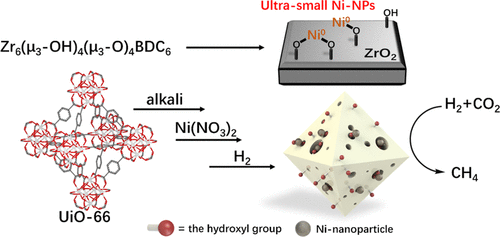当前位置:
X-MOL 学术
›
ACS Appl. Mater. Interfaces
›
论文详情
Our official English website, www.x-mol.net, welcomes your feedback! (Note: you will need to create a separate account there.)
Highly Dispersed Ni Catalyst on Metal–Organic Framework-Derived Porous Hydrous Zirconia for CO2 Methanation
ACS Applied Materials & Interfaces ( IF 9.5 ) Pub Date : 2020-04-01 , DOI: 10.1021/acsami.9b23277 Lingzhen Zeng 1 , Yongke Wang 1 , Zhe Li 1 , Yang Song 2 , Jingzheng Zhang 1 , Jing Wang 1 , Xuefeng He 1 , Cheng Wang 1 , Wenbin Lin 2
ACS Applied Materials & Interfaces ( IF 9.5 ) Pub Date : 2020-04-01 , DOI: 10.1021/acsami.9b23277 Lingzhen Zeng 1 , Yongke Wang 1 , Zhe Li 1 , Yang Song 2 , Jingzheng Zhang 1 , Jing Wang 1 , Xuefeng He 1 , Cheng Wang 1 , Wenbin Lin 2
Affiliation

|
We report the preparation of porous hydrous zirconia by treatment of zirconium-based metal–organic framework (MOF) UiO-66 with a strong base. Microporosity of the original MOF was partially retained in the resultant porous hydrous zirconia. NiII centers were then adsorbed onto the OH-rich hydrous zirconia and in situ converted to highly dispersed Ni0 for CO2 hydrogenation to CH4. The activated catalyst after an induction period showed a turnover frequency of 345 h–1 or a space–time yield of 5851 mmol·gNi–1·h–1 with a CH4 selectivity of over 99%. The catalyst was tested for 100 h on stream, showing only a 4% decrease in activity, and was found to convert atmospheric CO2 to CH4 via CO2 collection through Na2CO3/NaHCO3 cycling. Thermal decomposition of NaHCO3 released CO2 for hydrogenation to CH4, and the resultant Na2CO3 absorbed CO2 from air to form NaHCO3. This work highlights the opportunity in using MOFs as precursors to prepare highly porous metal oxide/hydroxide supports for solid–gas phase catalysis.
中文翻译:

金属-有机骨架衍生的多孔含水氧化锆上的高分散镍催化剂用于CO 2甲烷化
我们报道了通过处理具有强碱的锆基金属有机框架(MOF)UiO-66制备多孔含水氧化锆的方法。原始MOF的微孔部分保留在所得多孔含水氧化锆中。然后将Ni II中心吸附到富含OH的含水氧化锆上,并原位转化为高度分散的Ni 0,以将CO 2加氢成CH 4。诱导期后的活化催化剂显示周转频率为345 h –1或时空产率为5851 mmol·g Ni –1 ·h –1且具有CH 4选择性超过99%。将催化剂用于在流100h中进行测试,仅示出在活性的4%的降低,并发现大气中的CO转换2至CH 4经由CO 2收集通过的Na 2 CO 3 /碳酸氢钠3循环。NaHCO 3的热分解释放出CO 2以加氢成CH 4,所得Na 2 CO 3从空气中吸收CO 2形成NaHCO 3。这项工作凸显了使用MOF作为前体来制备高度多孔的金属氧化物/氢氧化物载体以进行固-气相催化的机会。
更新日期:2020-04-01
中文翻译:

金属-有机骨架衍生的多孔含水氧化锆上的高分散镍催化剂用于CO 2甲烷化
我们报道了通过处理具有强碱的锆基金属有机框架(MOF)UiO-66制备多孔含水氧化锆的方法。原始MOF的微孔部分保留在所得多孔含水氧化锆中。然后将Ni II中心吸附到富含OH的含水氧化锆上,并原位转化为高度分散的Ni 0,以将CO 2加氢成CH 4。诱导期后的活化催化剂显示周转频率为345 h –1或时空产率为5851 mmol·g Ni –1 ·h –1且具有CH 4选择性超过99%。将催化剂用于在流100h中进行测试,仅示出在活性的4%的降低,并发现大气中的CO转换2至CH 4经由CO 2收集通过的Na 2 CO 3 /碳酸氢钠3循环。NaHCO 3的热分解释放出CO 2以加氢成CH 4,所得Na 2 CO 3从空气中吸收CO 2形成NaHCO 3。这项工作凸显了使用MOF作为前体来制备高度多孔的金属氧化物/氢氧化物载体以进行固-气相催化的机会。


























 京公网安备 11010802027423号
京公网安备 11010802027423号